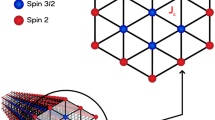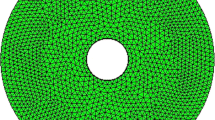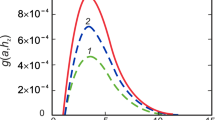Abstract
Magnetization reversal mechanism and stable remanent states of truncated conical nanowire of high aspect ratio are examined using micromagnetic simulation tool. The length of nanowire is fixed at \(1\,\upmu\)m, while its base radius R is varied from 50 to 10 nm and top radius r is varied \(R-\)10 nm to \(R-\)5 nm. The axial magnetization reversal proceeds predominantly through domain wall motion which is hindered as the tapering of the conical nanowire is increased. At remanence, a homogeneous magnetization persists throughout the nanowire except at the ends. Vortex states appear at both the ends in case of nanowires close to cylindrical shape, whereas a flower state of magnetization is exhibited at the tapered end if r is as small as \(\le 20\) nm. Control of magnetization reversal through propagation of domain wall can be observed as tapered end with flower configuration successfully restricts the movement of domain wall. Expressions for total energy density of both vortex-vortex state and vortex-flower state are constructed, and the obtained values are compared with homogeneous configuration to understand the extent of stability. The transition of remanent state is successfully obtained by energy calculations. Angular dependency of coercivity shows the existence of a critical angle above which the coercivity follows Stoner–Wohlfarth model. Below the critical angle, the coercivity mechanism is explained by Kondorsky model if R is large, whereas a modified Kondorsky model is applicable for small base radius.

















Similar content being viewed by others
Data and code availability
The data that support the findings of this study may be availed from the corresponding author upon reasonable request.
References
Shi KL, Wang Z, Jiang W (2023a) Monte carlo simulation of magnetic and thermodynamic properties of hexagonal decorated nanoparticle in a magnetic field. Journal of Materials Science pp 1–22. https://doi.org/10.1007/s10853-023-08504-5
Shi KL, Quan XW, Jiang W (2023) Study on the magnetic and hysteresis behaviors in a bilayer graphene-like ring with edge decorated. Phys Scr 98(1):015,822. https://doi.org/10.1088/1402-4896/aca2f1
Blasing R, Khan AA, Filippou PC et al (2020) Magnetic racetrack memory: From physics to the cusp of applications within a decade. Proc IEEE 108(8):1303–1321. https://doi.org/10.1109/JPROC.2020.2975719
Allwood DA, Xiong G, Faulkner CC et al (2005) Magnetic domain-wall logic. Science 309(5741):1688–1692. https://doi.org/10.1126/science.1108813
Lin WS, Lin HM, Chen HH et al (2013) (2013) Shape effects of iron nanowires on hyperthermia treatment. J Nanomater 237:439. https://doi.org/10.1155/2013/237439
Sharma M, Kuanr BK (2019) Microwave devices based on template-assisted nife nanowires: fabrication and characterization. J Phys D Appl Phys 53(6):065,001. https://doi.org/10.1088/1361-6463/ab55a4
Ren Y, Wang J, Liu Q et al (2011) Tailoring coercivity and magnetic anisotropy of co nanowire arrays by microstructure. J Mater Sci 46(23):7545–7550. https://doi.org/10.1007/s10853-011-5727-x
Hertel R (2016) Ultrafast domain wall dynamics in magnetic nanotubes and nanowires. J Phys Condens Matter 28(48):483,002. https://doi.org/10.1088/0953-8984/28/48/483002
Moreno JA, Bran C, Vazquez M et al (2021) Cylindrical magnetic nanowires applications. IEEE Trans Magn 57(4):1–17. https://doi.org/10.1109/TMAG.2021.3055338
Ramirez-Villegas R, Huynen I, Piraux L et al (2016) Configurable microwave filter for signal processing based on arrays of bistable magnetic nanowires. IEEE Trans Microw Theory Tech 65(1):72–77. https://doi.org/10.1109/TMTT.2016.2614926
Forster H, Schrefl T, Scholz W et al (2002) Micromagnetic simulation of domain wall motion in magnetic nano-wires. J Magn Magn Mater 249(1–2):181–186. https://doi.org/10.1016/S0304-8853(02)00528-0
Yang H, Li Y, Zeng M et al (2016) Static and dynamic magnetization of gradient feni alloy nanowire. Sci Rep 6(1):1–9. https://doi.org/10.1038/srep20427
Garcia J, Fernandez-Roldan JA, Gonzalez R et al (2021) Narrow segment driven multistep magnetization reversal process in sharp diameter modulated fe67co33 nanowires. Nanomaterials 11(11):3077. https://doi.org/10.3390/nano11113077
Berganza E, Jaafar M, Bran C et al (2017) Multisegmented nanowires: a step towards the control of the domain wall configuration. Sci Rep 7(1):11,576. https://doi.org/10.1038/s41598-017-11902-w
Salem MS, Tejo F, Zierold R et al (2018) Composition and diameter modulation of magnetic nanowire arrays fabricated by a novel approach. Nanotechnology 29(6):065,602. https://doi.org/10.1088/1361-6528/aaa095
Saez G, Diaz P, Cisternas E et al (2021) Information storage in permalloy modulated magnetic nanowires. Sci Rep 11(1):1–9. https://doi.org/10.1038/s41598-021-00165-1
Arzuza L, Lopez-Ruiz R, Salazar-Aravena D et al (2017) Domain wall propagation tuning in magnetic nanowires through geometric modulation. J Magn Magn Mater 432:309–317. https://doi.org/10.1016/j.jmmm.2017.01.071
Rodriguez LA, Bran C, Reyes D et al (2016) Quantitative nanoscale magnetic study of isolated diameter-modulated fecocu nanowires. ACS Nano 10(10):9669–9678. https://doi.org/10.1021/acsnano.6b05496
Fernandez-Roldan JA, Perez del Real R, Bran C et al (2018) Magnetization pinning in modulated nanowires: from topological protection to the “corkscrew’’ mechanism. Nanoscale 10(13):5923–5927. https://doi.org/10.1039/C8NR00024G
Saez G, Cisternas E, Diaz P et al (2020) Tuning the coercive field by controlling the magnetization reversal process in permalloy modulated nanowires. J Magn Magn Mater 512(167):045. https://doi.org/10.1016/j.jmmm.2020.167045
Saavedra E, Saez G, Diaz P et al (2019) Dynamic susceptibility of modulated magnetic nanowires. AIP Adv 9(6):065,007. https://doi.org/10.1063/1.5091813
Burn DM, Arac E, Atkinson D (2013) Magnetization switching and domain-wall propagation behavior in edge-modulated ferromagnetic nanowire structures. Phys Rev B 88(10):104,422. https://doi.org/10.1103/PhysRevB.88.104422
Fernandez-Roldan JA, De Riz A, Trapp B et al (2019) Modeling magnetic-field-induced domain wall propagation in modulated-diameter cylindrical nanowires. Sci Rep 9(1):1–12. https://doi.org/10.1038/s41598-019-40794-1
Liu D, Zhao T, Zhang M et al (2021) Exploration of nontrivial topological domain structures in the equilibrium state of magnetic nanodisks. J Mater Sci 56:4677–4685. https://doi.org/10.1007/s10853-020-05569-4
Schoberl J (1997) Netgen an advancing front 2d/3d-mesh generator based on abstract rules. Comput Vis Sci 1(1):41–52. https://doi.org/10.1007/s007910050004
Venkat G, Venkateswarlu D, Joshi R et al (2018) Enhanced spin wave propagation in magnonic rings by bias field modulation. AIP Adv 8(5):056,006. https://doi.org/10.1063/1.5006576
Fischbacher T, Franchin M, Bordignon G et al (2007) A systematic approach to multiphysics extensions of finite-element-based micromagnetic simulations: Nmag. IEEE Trans Magn 43(6):2896–2898. https://doi.org/10.1109/TMAG.2007.893843
Ramachandran P, Varoquaux G (2011) Mayavi: 3d visualization of scientific data. Comput Sci Eng 13(2):40–51. https://doi.org/10.1109/MCSE.2011.35
Ivanov YP, Vazquez M, Chubykalo-Fesenko O (2013) Magnetic reversal modes in cylindrical nanowires. J Phys D Appl Phys 46(48):485,001. https://doi.org/10.1088/0022-3727/46/48/485001
Yan M, Wang H, Campbell CE (2008) Unconventional magnetic vortex structures observed in micromagnetic simulations. J Magn Magn Mater 320(13):1937–1944. https://doi.org/10.1016/j.jmmm.2008.02.170
Dao N, Donahue M, Dumitru I et al (2004) Dynamic susceptibility of nanopillars. Nanotechnology 15(10):S634. https://doi.org/10.1088/0957-4484/15/10/022
Ross C, Farhoud M, Hwang M et al (2001) Micromagnetic behavior of conical ferromagnetic particles. J Appl Phys 89(2):1310–1319. https://doi.org/10.1063/1.1331656
Bran C, Fernandez-Roldan JA, Del Real RP et al (2021) Magnetic configurations in modulated cylindrical nanowires. Nanomaterials 11(3):600. https://doi.org/10.3390/nano11030600
Feldtkeller E, Thomas H (1965) Struktur und energie von blochlinien in dünnen ferromagnetischen schichten. Physik der kondensierten Materie 4(1):8–14. https://doi.org/10.1007/BF02423256
Sahu R, Mishra AC (2022) Magnetization reversal and ground states in thin truncated conical nanodisks: analytical and micromagnetic modelling approach. J Magn Magn Mater 556(169):356. https://doi.org/10.1016/j.jmmm.2022.169356
Raviolo S, Tejo F, Bajales N et al (2018) Angular dependence of the magnetic properties of permalloy and nickel nanowires as a function of their diameters. Mater Res Exp 5(1):015,043. https://doi.org/10.1088/2053-1591/aaa537
Tejo F, Vidal-Silva N, Espejo A et al (2014) Angular dependence of the magnetic properties of cylindrical diameter modulated ni80fe20 nanowires. J Appl Phys 115(17):17D136. https://doi.org/10.1063/1.4865777
Elk K, Jahn L (1991) Angular dependence and competition of coercivity mechanisms. J Magn Magn Mater 102(1–2):159–165. https://doi.org/10.1016/0304-8853(91)90282-F
Harres A, Mallmann TA, Gamino M et al (2022) Magnetization reversal processes in amorphous cofeb thin films. J Magn Magn Mater 552(169):135. https://doi.org/10.1016/j.jmmm.2022.169135
Bernasconi J, Strassler S, Perkins RS (1975) Simple models for the coercivity of hard magnetic materials. AIP Conf Proc 24(1):761–762. https://doi.org/10.1063/1.30278
Ratnam D, Buessem W (1972) Angular variation of coercive force in barium ferrite. J Appl Phys 43(3):1291–1293. https://doi.org/10.1063/1.1661260
Tu H, You B, Gao Y et al (2016) The thickness-dependent in-plane uniaxial magnetic anisotropy in amorphous cofeb films on gaas (001) substrates. J Supercond Novel Magn 29:2843–2848. https://doi.org/10.1007/s10948-016-3615-y
Schumacher F (1991) On the modification of the kondorsky function. J Appl Phys 70(6):3184–3187. https://doi.org/10.1063/1.349301
Delalande M, de Vries J, Abelmann L et al (2012) Measurement of the nucleation and domain depinning field in a single co/pt multilayer dot by anomalous hall effect. J Magn Magn Mater 324(7):1277–1280. https://doi.org/10.1016/j.jmmm.2011.09.037
Huang HL, Sobolev VL (1993) Domain wall structure and the re-modified Kondorsky function. IEEE Trans Magn 29(6):2539–2541. https://doi.org/10.1109/20.280961
Acknowledgements
Akhila Priya Kotti and Rahul Sahu would like to thank Ministry of Human Resource Development (MHRD), New Delhi, for providing financial assistance for carrying out this work.
Author information
Authors and Affiliations
Contributions
A.P. Kotti helped in conception and design of study, data curation, investigation and writing—first draft. R. Sahu was involved in conception and design of study, data curation and visualization. A.C. Mishra contributed to conceptualization, supervision, writing—review and editing.
Corresponding author
Ethics declarations
Conflict of interest
The authors declare that there are no competing financial interests or personal ties that could have influenced the research presented in this study.
Additional information
Handling Editor: Dale Huber.
Publisher's Note
Springer Nature remains neutral with regard to jurisdictional claims in published maps and institutional affiliations.
Appendices
Appendix A Total energy density for vortex-vortex state
In order to include the effect of top and bottom surface, the continuum function is divided into two parts for each half of the wire.
Here \(\eta\) and \(\lambda\) are parameters useful to control the effective length of the vortex on bottom and top surface, respectively.
Now the exchange energy can be calculated by using
On the curved surface, the variation of z is given as \(z=\left( \frac{R-\rho }{R-r}\right) h\) (See Fig. 18). Now we use Eq. 3 and solve to give
For bottom half \(0\le z\le \frac{h}{2}\)
For top half \(\frac{h}{2} \le z\le h\)
By substituting in Eq. A2
where \(\rho _{\mathrm{lim}}=R-\left( \frac{R-r}{h}\right) z\), \(c_{1}=1-\frac{2z}{h}\), \(c_{2}=\frac{2z}{h}-1\), \(f_{1}=N_{0}e^{-2\rho ^n\beta _{0}^n\left( c_1\right) ^{\eta n}}\), \(f_{2}=N_{0}e^{-2\rho ^n\beta _{0}^n\left( c_1\right) ^{\eta n}}+\left( 1-N_{0}\right)\), \(f_{3}= N_{h}e^{-2\rho ^n \beta _{h}^n\left( c_{2}\right) ^{\lambda n}}\) and \(f_{4}= N_{h}e^{-2\rho ^n\beta _{h}^n\left( c_{2}\right) ^{\lambda n}}+\left( 1-N_{h}\right)\)
Volume of the truncated conical nanodisk is calculated using
which is found to be
The dipolar interaction energy is given as
where the magnetic potential is
To calculate the volume magnetic potential, we first solve divergence of \(\vec {M}\)
for \(0\le z\le \frac{h}{2}\)
for \(\frac{h}{2}\le z\le h\)
where \(c_3=1-\frac{2z^\prime }{h}\), \(c_4=\frac{2z^\prime }{h}-1\) and \(f_5= N_{0} e^{-2\rho ^{\prime ^n}\beta _{0}^n \left( c_3\right) ^{\eta n}}\), \(f_6= N_{h} e^{-2\rho ^{\prime ^n}\beta _{h}^n\left( c_4\right) ^{\lambda n}}\)
Substitute in the first half of Eq. A10
The radial part can be expressed as
where \(J_{p}\) are the first kind Bessel functions and using
After solving the radial part using above expression, we have
Substituting the divergence of \(\vec {M}\) expressions appropriately
Here, we have \(\rho ^\prime _{\mathrm{lim}}= R-\left( \frac{R-r}{h}\right) z^\prime\)
\(\vec {M}(r)\) has both \(\varphi\) and z components. Thus, we need only these components of \(\vec {\nabla }U_{\nu }(r)\). But \(\vec {\nabla }U_{\nu }(r)_\varphi =0\). So we solve only the z-component to calculate the required dipolar energy.
where \(J_{00}=\int _{0}^{\infty } ksgn(z-z^\prime ) J_{0}(k\rho )J_{0}(k\rho ^\prime )e^{k(z_<-z_>)}\text {d}k\)
Now, the dipolar energy is calculated by substituting the interacting potential
By further simplification
The equation of curved surface is of the form
Here, the unit vector is
Dot product with magnetization yields
On the top surface
On the bottom surface
Along the curved surface, we have \(ds^\prime =\rho ^\prime \text {d}\rho ^\prime \text {d}\varphi ^\prime \sec \gamma ,\) where \(\sec \gamma = \frac{\sqrt{h^2+(R-r)^2}}{R-r}\)
The surface interacting potential due to the top, bottom and curved surface is
where \(f_7 =N_{0}e^{-2\rho ^{\prime ^n}\beta _{0}^n}+\left( 1-N_{0}\right)\), \(f_8 = N_{h}e^{-2\rho ^{\prime ^n}\beta _{h}^n}+\left( 1-N_{h}\right)\), \(f_9= N_{0} e^{-2\rho ^{\prime ^n}\beta _{0}^n \left( c_3\right) ^{\eta n}}+\left( 1-N_{0}\right)\), \(f_{10}= N_{h} e^{-2\rho ^{\prime ^n}\beta _{h}^n\left( c_4\right) ^{\lambda n}}+\left( 1-N_{h}\right)\) and \(z^\prime =\left( \frac{R-\rho ^\prime }{R-r}\right) h\)
Again, only the z-component is required
The dipolar surface energy is calculated as
Appendix B Total energy density for vortex-flower state
Calculation of dipolar energy requires the divergence of \(\vec {M}\)
for \(0\le z\le \frac{h}{2}\)
which is similar to vortex-vortex state, as the vortex is still stabilized on the bottom half.
for \(\frac{h}{2} \le z\le h\)
Here \(T_1\) and \(T_2\) are solved as
Magnetic potential is given as
For the bottom half, we require only the z-component of \(\vec {\nabla }U_{\nu }(r)\), as it exhibits vortex configuration. But for the top half, due to flower domain configuration \(\vec {M}(r^\prime )\) has both \(\rho\) and z component. So we need both of these components for \(\vec {\nabla }U_{\nu }(r)\).
Here \(J_{10} =\int _{0}^{\infty }k J_{1}(k\rho )J_{0}(k\rho ^\prime )e^{k(z_<-z_>)}\text {d}k\)
Using Eq. B18 and Eq. B19, we have
Now the dipolar contribution of bottom surface is calculated in a similar fashion to vortex-vortex state, but for the top half, i.e.
for \(\frac{h}{2} \le z\le h\)
The potential with contributions from top, bottom and curved surface is followed as
Using the simplification procedure for radial component yields
Again we require both z and \(\rho\) components of \(\vec {\nabla }U_s(r)\)
where \(I_{00} = \int _{0}^{\infty }k sgn\left( z-\left( \frac{R-\rho ^\prime }{R-r}\right) h\right) J_{0}(k\rho )J_{0}(k\rho ^\prime )e^{-k|z-\left( \frac{R-\rho ^\prime }{R-r}\right) h|}\text {d}k\)
Substitution of above equations gives the expression for surface dipolar energy as
Appendix C Angular variation of dipolar energy for homogeneous state
The magnetization of single-domain state along an arbitrary direction that makes an angle \(\psi\) with the z-axis can be represented as
Using Eq. A1, the exchange energy is found to be zero.
For the dipolar energy, there is no volume contribution as the divergence of \(\vec {M}\) is again zero. We have only the surface contribution.
From Eq. A14,
On the top surface
On the bottom surface
The expression for surface potential after including the top, bottom and curved part becomes
By using Eq. A11 and Eq. A12 along with \(\int _{0}^{2\pi }e^{-ip\varphi \prime } cos \varphi ^\prime \text {d}\varphi ^\prime =\pi \delta _{p1,-1}\) to solve the radial part, we have
Using Eq. A9, the surface dipolar interaction energy energy is calculated as
Here \(K_{00}=\int _{0}^{\infty }J_{0}(k\rho )J_{0}(k\rho ^\prime )k sgn\left( h\left( \frac{R-\rho ^\prime }{R-r}\right) -z\right) e^{-k|z-h\left( \frac{R-\rho ^\prime }{R-r}\right) |}\text {d}k\) and
\(K_{11}=\int _{0}^{\infty }J_{1}(k\rho )J_{1}(k\rho ^\prime )k sgn\left( h\left( \frac{R-\rho ^\prime }{R-r}\right) -z\right) e^{-k|z-h\left( \frac{R-\rho ^\prime }{R-r}\right) |}\text {d}k\)
Here \(K_{01}=\int _{0}^{\infty } k J_{0}(k\rho )J_{1}(k\rho ^\prime )e^{-k|z-h\left( \frac{R-\rho ^\prime }{R-r}\right) |}\text {d}k\)
Rights and permissions
Springer Nature or its licensor (e.g. a society or other partner) holds exclusive rights to this article under a publishing agreement with the author(s) or other rightsholder(s); author self-archiving of the accepted manuscript version of this article is solely governed by the terms of such publishing agreement and applicable law.
About this article
Cite this article
Kotti, A.P., Sahu, R. & Mishra, A.C. Magnetization reversal and coercivity mechanism in truncated conical nanowires of permalloy. J Mater Sci 58, 11115–11138 (2023). https://doi.org/10.1007/s10853-023-08722-x
Received:
Accepted:
Published:
Issue Date:
DOI: https://doi.org/10.1007/s10853-023-08722-x





